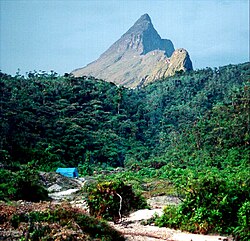Pico 31 de Março
| Pico 31 de Março | |
|---|---|

Pico 31 de Março is the small round blue-shaded summit behind its higher and sharper neighbour, Pico da Neblina, which is shown on the foreground.
|
|
| Highest point | |
| Elevation | 2,974.18 m (9,757.8 ft) |
| Parent peak | Pico da Neblina |
| Coordinates | 0°48′N 66°00′W / 0.800°N 66.000°WCoordinates: 0°48′N 66°00′W / 0.800°N 66.000°W |
| Geography | |
| Location |
|
| Parent range | Cerro de la Neblina, a section of Serra do Imeri in the Guiana Highlands |
| Climbing | |
| First ascent | 1965 |
| Easiest route | From the Brazilian town of São Gabriel da Cachoeira to Iazinho river by truck, then by boat on Iazinho river, Ia river, Caburaí river and Tucano river, then on a jungle trail with three camps (Tucano, Bebedouro Novo, Garimpo do Tucano) before the final ascent. This is the same route used for neighbouring Pico da Neblina. |
Pico 31 de Março, or Pico Trinta e Um de Março in full (Portuguese pronunciation: [ˈpiku ˈtɾĩtɐ jũ dʒi ˈmaʁsu]), also known as Pico Phelps, is a mountain on the Brazil–Venezuela border. At 2,974 metres (9,757 ft) above sea level, it is Brazil's second highest mountain. It is part of the Neblina massif, and the latter's summit Pico da Neblina, Brazil's highest summit, is only 687 m (2,254 ft) away. Pico 31 de Março can be considered a secondary summit of Pico da Neblina. Therefore, it is usually climbed by expeditions primarily aiming to reach the other peak. Pico 31 de Março is linked to Pico da Neblina by a col that can be easily traversed in a short trek of about an hour.
The peak was first discovered in 1954 by the Basset Maguire's expedition to the north side of the mountain massif. It was later climbed during the first attempt to climb Pico da Neblina, by a Brazilian army expedition. It received its name (meaning "March 31 Peak" in Portuguese) as a self-homage by the military regime instated in Brazil a few months earlier on that date, in a coup d'état which was then officially called the "March 31 Revolution." The peak was finally reached in the following year by another army expedition to Pico da Neblina. The name was not changed after Brazil returned to democratic rule in 1985. The peak is known as Pico Phelps in Venezuela, and it is that country's highest point outside of the Andes.
Pico da Neblina, in whose massif Pico 31 de Março is located, is the highest point on the Guiana Shield. Neblina means "fog" in both Portuguese and Spanish. The mountains are contained in the Brazilian Pico da Neblina National Park; their northern slopes are also protected in Venezuela's Serranía de la Neblina National Park. The twin parks, together with the neighbouring Parima Tapirapecó National Park (Venezuela), form a protected area complex of about 80,000 km², possibly the largest national park system on tropical rainforests in the world.
...
Wikipedia

